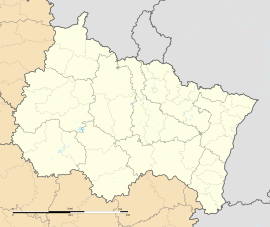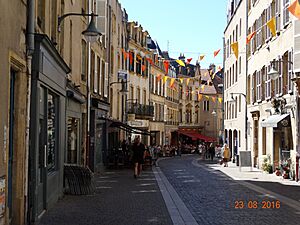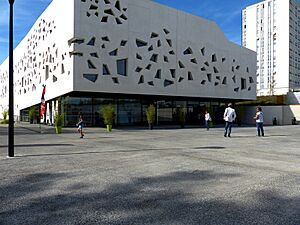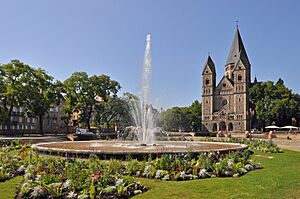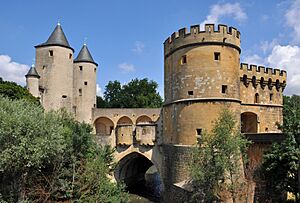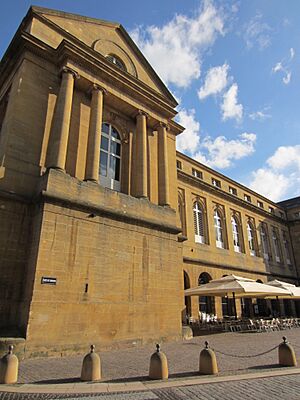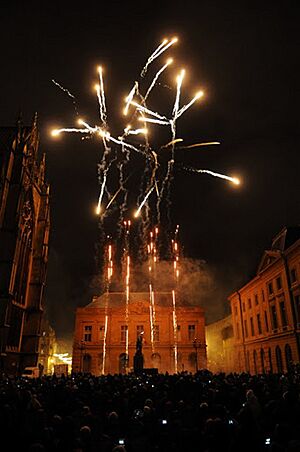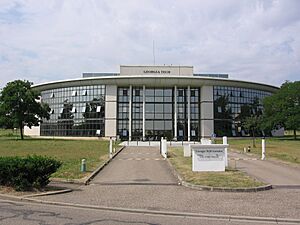Metz facts for kids
Quick facts for kids
Metz
|
|||
|---|---|---|---|
|
Prefecture and commune
|
|||
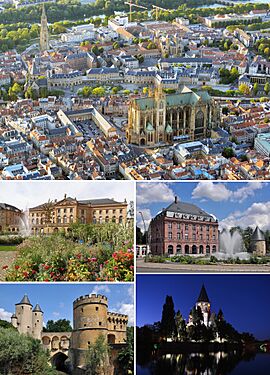
Clockwise from top: overview of city centre 1(with Cathedral of Saint Stephen), Imperial Quarter, Temple Neuf, Germans' Gate, Opéra-Théâtre (place de la Comédie)
|
|||
|
|||
| Country | France | ||
| Region | Grand Est | ||
| Department | Moselle | ||
| Arrondissement | Metz | ||
| Canton | 3 cantons | ||
| Intercommunality | Metz Métropole | ||
| Area
1
|
41.94 km2 (16.19 sq mi) | ||
| • Urban | 308.8 km2 (119.2 sq mi) | ||
| • Metro | 1,877.2 km2 (724.8 sq mi) | ||
| Population
(2021)
|
120,874 | ||
| • Density | 2,882.1/km2 (7,464.5/sq mi) | ||
| • Urban
(2018)
|
285,930 | ||
| • Urban density | 925.94/km2 (2,398.2/sq mi) | ||
| • Metro
(2018)
|
367,851 | ||
| • Metro density | 195.957/km2 (507.527/sq mi) | ||
| Demonym(s) | Messin (masculine) Messine (feminine) |
||
| Time zone | UTC+01:00 (CET) | ||
| • Summer (DST) | UTC+02:00 (CEST) | ||
| INSEE/Postal code |
57463 /57000
|
||
| Elevation | 162–256 m (531–840 ft) | ||
| Website | Metz Ville | ||
| 1 French Land Register data, which excludes lakes, ponds, glaciers > 1 km2 (0.386 sq mi or 247 acres) and river estuaries. | |||
Metz (pronounced like "Mets") is a city in northeast France. It's located where the Moselle and Seille rivers meet. Metz is the main city of the Moselle area and the home of the parliament for the Grand Est region. It's close to where France, Germany, and Luxembourg meet, making it a key city in the European Greater Region.
Metz has a long history, going back 3,000 years! It was once a Celtic town, an important Gallo-Roman city, and even the capital of a kingdom called Austrasia. It's also known as the birthplace of the Carolingian dynasty and Gregorian chant. Metz has a strong French culture, but its location and history mean it's also been influenced by German culture.
Because of its amazing history, culture, and buildings, Metz is being considered for UNESCO World Heritage status. The city has many famous buildings, like the Gothic Saint-Stephen Cathedral, which has the most stained-glass windows in the world. The Basilica of Saint-Pierre-aux-Nonnains is the oldest church in France. The Imperial Station Palace even has an apartment for the German Kaiser (Emperor). The Opera House is the oldest one still working in France. Metz also has world-class venues like the Arsenal Concert Hall and the Centre Pompidou-Metz museum.
Metz is known as "The Green City" (La Ville Verte) because it has lots of parks and public gardens. The old city center is one of the biggest shopping areas in France where only people can walk.
Metz has always been an important military town. Today, it's the economic center of the Lorraine region, focusing on information technology and the car industry. It's home to the University of Lorraine and Georgia Tech Lorraine. It's also a hub for research in materials, especially metallurgy (working with metals), which comes from Lorraine's history in the iron and steel industry.
Contents
What's in a Name?
In ancient times, Metz was called "city of Mediomatrici" after the tribe living there. When it became part of the Roman Empire, it was named Divodurum Mediomatricum, meaning "Holy Village" or "Holy Fortress of the Mediomatrici." Later, it was simply called Mediomatrix. Around the 5th century AD, the name changed to "Mettis," which eventually became the "Metz" we know today.
A Journey Through Time

Metz has a recorded history that goes back over 2,000 years. Before Julius Caesar conquered Gaul in 52 BC, it was a Celtic town. When it joined the Roman Empire, Metz quickly became one of the main cities in Gaul, with 40,000 people. But then, during a time of big migrations, it faced attacks and was taken over by the Franks around the end of the 5th century.
From the 6th to 8th centuries, Metz was where the Merovingian kings of Austrasia lived. After a treaty in 843, Metz became the capital of the Kingdom of Lotharingia. Eventually, it joined the Holy Roman Empire and gained some independence. In the 12th century, Metz became a republic, which lasted until the 15th century.
In 1552, Metz became part of the Kingdom of France through a treaty. Even though the Holy Roman Empire didn't agree at first, it was officially recognized as French in 1648. Under French rule, Metz became a very important fortified town. When France created its departments in 1789, Metz was chosen as the capital of the Moselle Department.
After the Franco-Prussian War in 1871, Metz became part of the German Empire, even though most people spoke French. It was the capital of the Lorraine region within the German Empire.
Metz remained German until the end of First World War, when it returned to France. However, during Second World War, Nazi Germany took control of the city. In 1944, the U.S. Third Army fought to free Metz, and it became French again after the war.
In the 1950s, Metz was chosen as the capital of the new Lorraine region. With the creation of the European Community and later the European Union, Metz has become a central city in the Greater Region and the SaarLorLux Euroregion.
Where is Metz?
Metz is located on the banks of the Moselle and Seille rivers. It's about 43 kilometers (27 miles) from the Schengen point where the borders of France, Germany, and Luxembourg meet. The city was built in a spot where the Moselle river splits into several islands, which are now part of the city's design.
Metz is part of the Paris Basin and has a plateau-like landscape with river valleys. The area around Metz is part of the Lorraine Regional Natural Park, which covers a huge area of 205,000 hectares (506,500 acres) of forests and farms.
Weather in Metz
The Lorraine region has an oceanic climate, which means it's influenced by the ocean but also has some features of a continental climate. Summers are warm and humid, sometimes with thunderstorms. July is the warmest month, with daytime temperatures around 25°C (77°F). Winters are cold but don't get a lot of snow. The average low in January is about -0.5°C (31°F). Snow can fall from November to February.
The amount of daylight changes a lot throughout the year. The shortest day is December 21st, with about 7.5 hours of sunlight. The longest day is June 20th, with about 16.5 hours of sunlight.
| Climate data for Metz-Frescaty, elevation: 192 m (630 ft), 1991–2020 normals, extremes 1940–present | |||||||||||||
|---|---|---|---|---|---|---|---|---|---|---|---|---|---|
| Month | Jan | Feb | Mar | Apr | May | Jun | Jul | Aug | Sep | Oct | Nov | Dec | Year |
| Record high °C (°F) | 16.1 (61.0) |
20.8 (69.4) |
25.1 (77.2) |
29.6 (85.3) |
33.2 (91.8) |
37.7 (99.9) |
39.7 (103.5) |
39.5 (103.1) |
34.3 (93.7) |
26.8 (80.2) |
23.3 (73.9) |
18.1 (64.6) |
39.7 (103.5) |
| Mean daily maximum °C (°F) | 5.4 (41.7) |
7.1 (44.8) |
11.6 (52.9) |
16.0 (60.8) |
20.0 (68.0) |
23.6 (74.5) |
25.8 (78.4) |
25.5 (77.9) |
20.9 (69.6) |
15.4 (59.7) |
9.4 (48.9) |
6.0 (42.8) |
15.6 (60.1) |
| Daily mean °C (°F) | 2.7 (36.9) |
3.6 (38.5) |
7.0 (44.6) |
10.5 (50.9) |
14.5 (58.1) |
17.9 (64.2) |
20.1 (68.2) |
19.7 (67.5) |
15.7 (60.3) |
11.3 (52.3) |
6.5 (43.7) |
3.5 (38.3) |
11.1 (52.0) |
| Mean daily minimum °C (°F) | 0.0 (32.0) |
0.1 (32.2) |
2.4 (36.3) |
4.9 (40.8) |
9.0 (48.2) |
12.3 (54.1) |
14.4 (57.9) |
14.0 (57.2) |
10.4 (50.7) |
7.2 (45.0) |
3.6 (38.5) |
1.0 (33.8) |
6.6 (43.9) |
| Record low °C (°F) | −20.1 (−4.2) |
−23.2 (−9.8) |
−15.3 (4.5) |
−5.1 (22.8) |
−2.5 (27.5) |
1.9 (35.4) |
4.3 (39.7) |
3.9 (39.0) |
−1.1 (30.0) |
−6.2 (20.8) |
−11.7 (10.9) |
−17.0 (1.4) |
−23.2 (−9.8) |
| Average precipitation mm (inches) | 61.9 (2.44) |
56.0 (2.20) |
51.1 (2.01) |
45.1 (1.78) |
56.9 (2.24) |
56.1 (2.21) |
59.8 (2.35) |
59.3 (2.33) |
61.5 (2.42) |
64.8 (2.55) |
64.5 (2.54) |
76.5 (3.01) |
713.5 (28.09) |
| Average precipitation days (≥ 1.0 mm) | 11.1 | 10.0 | 9.9 | 8.3 | 9.6 | 9.1 | 8.9 | 9.0 | 8.4 | 10.3 | 11.4 | 12.2 | 118.1 |
| Average snowy days | 7.8 | 6.3 | 4.6 | 1.9 | 0.1 | 0 | 0 | 0 | 0 | 0.1 | 1.3 | 5.7 | 27.8 |
| Mean monthly sunshine hours | 52.7 | 79.1 | 127.1 | 177 | 201.5 | 219 | 226.3 | 213.9 | 159 | 99.2 | 48 | 40.3 | 1,643.1 |
| Mean daily sunshine hours | 1.7 | 2.8 | 4.1 | 5.9 | 6.5 | 7.3 | 7.3 | 6.9 | 5.3 | 3.2 | 1.6 | 1.3 | 4.5 |
| Mean daily daylight hours | 8.8 | 10.2 | 11.9 | 13.8 | 15.3 | 16.1 | 15.7 | 14.3 | 12.6 | 10.8 | 9.2 | 8.3 | 12.3 |
| Source 1: Meteo France | |||||||||||||
| Source 2: Weather Atlas(snowy days-sun-daylight) | |||||||||||||
People of Metz

Metz with its magnificent open countries, prolific undulating rivers, wooded hillsides, vineyards of fire; cathedral all in volute, where the wind sings as a flute, and responding to it via the Mutte: this big voice of the good Lord!
The people who live in Metz are called Messin (for boys and men) or Messine (for girls and women). In 2018, about 116,581 people lived in Metz, and the larger metropolitan area had around 368,000 people. Metz's population has changed a lot throughout history due to wars and changes in who controlled the city. More recently, changes in the military and metal industries have also affected the population.
| Historical population | |||||||||||||||||||||||||||||||||||||||||||||||||||||||||||||||||||||||||||||||||||||||||||||||||||||||||||
|---|---|---|---|---|---|---|---|---|---|---|---|---|---|---|---|---|---|---|---|---|---|---|---|---|---|---|---|---|---|---|---|---|---|---|---|---|---|---|---|---|---|---|---|---|---|---|---|---|---|---|---|---|---|---|---|---|---|---|---|---|---|---|---|---|---|---|---|---|---|---|---|---|---|---|---|---|---|---|---|---|---|---|---|---|---|---|---|---|---|---|---|---|---|---|---|---|---|---|---|---|---|---|---|---|---|---|---|
|
|
|
|||||||||||||||||||||||||||||||||||||||||||||||||||||||||||||||||||||||||||||||||||||||||||||||||||||||||
| Source: EHESS and INSEE | |||||||||||||||||||||||||||||||||||||||||||||||||||||||||||||||||||||||||||||||||||||||||||||||||||||||||||
Famous People from Metz
Many famous people have connections to Metz. These include the poet Paul Verlaine, composer Ambroise Thomas, and mathematician Jean-Victor Poncelet. Some well-known German figures were also born in Metz during times when Germany controlled the city. Other famous residents include the writer François Rabelais, political thinker Alexis de Tocqueville, and the inventor of the motion picture camera, Louis Le Prince. The French hero of the American Revolutionary War, Marquis Gilbert du Motier de La Fayette, and European statesman Robert Schuman also lived here.
City Life and Green Spaces
Metz has a mix of old and new buildings, showing its long history where different cultures met. The city has one of the largest Urban Conservation Areas in France, meaning many old buildings are protected. More than 100 buildings in Metz are listed as Historic Monuments. Because of its history and culture, Metz is called a "French Town of Art and History" and is being considered for UNESCO World Heritage status.
The city is known for its yellow limestone buildings, made from a stone called Jaumont stone. The historic area still has parts of the old Gallo-Roman city, including its main streets.
Metz Architecture Through the Ages
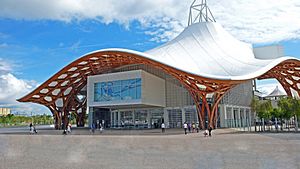
From its Gallo-Roman past, Metz still has parts of ancient baths (under the Golden Courtyard museum), pieces of an aqueduct, and the Basilica of Saint-Pierre-aux-Nonnains.
Saint Louis' square, with its arched walkways and a Knights Templar chapel, is a key part of the city's High Medieval history. The Gothic Saint-Stephen Cathedral, other churches, and old mansions show the Late Middle Ages. You can see Renaissance buildings from the 16th century, like the House of Heads.
The city hall and buildings around the main square were designed by French architect Jacques-François Blondel in the 1700s. Neoclassical buildings from the 18th century, like the Opera House, are also in the city.
The Imperial District was built when Germany controlled Metz. Emperor Wilhelm II wanted a new district with a mix of German architectural styles, like Renaissance and neo-Romanesque. Instead of the usual Jaumont stone, they used stones from the Rhineland. This district includes the rail station and the Central Post Office.
You can also find Modern architecture in Metz, with works by French architects. The Ney Arsenal was turned into a Concert Hall in 1989, and the Metz Arena was built in 2002, showing Postmodern styles.
The Centre Pompidou-Metz museum is a modern landmark. Designed by Japanese architect Shigeru Ban, its roof is a complex and innovative wooden structure. This project also includes designs by other famous architects. The area around it is still being developed and should be finished by 2023.
Metz: The Green City
Metz was one of the first cities to focus on "urban ecology" in the early 1970s, led by botanist Jean-Marie Pelt. This idea was about better connecting people with their environment, especially focusing on "stone and water." This led to many open green spaces along the Moselle and Seille rivers, and large areas where only pedestrians can walk. As a result, Metz has over 37 square meters (400 sq ft) of green space per person in its many public gardens.
Metz continues to be a green city today, with plans to make old buildings more sustainable and build new green districts. They also promote green public transport and create new public gardens.
The city even has its own power station that uses waste wood from nearby forests to create energy. This plant is very efficient and provides electricity and heat for 44,000 homes. It's the first local energy producer and distributor in France.
Military Buildings
Metz has a long history as a military town, so it has many military buildings. You can still see parts of old Defensive walls from ancient times up to the 20th century, often built into public gardens. The Germans' Gate (Porte des Allemands) is a medieval bridge castle from the 13th century, now used as an exhibition center. It's one of the city's most famous landmarks.
You can also see parts of the 16th-century citadel and fortifications from the 1740s. Many old barracks from the 18th and 19th centuries are around the city. Some, like the Arsenal Concert Hall, have been turned into civilian buildings.
The city is surrounded by many forts, including early examples of modern fort systems. Some forts were even part of the Maginot Line. You can hike on the Saint-Quentin plateau to see these old military forts and get a great view of the city.
Metz's Economy
While the steel industry was once very important in Moselle, Metz has worked to grow other areas like commerce, tourism, information technology, and the automotive industry. The city is the economic heart of the Lorraine region, with about 73,000 people working there every day. Metz is a transport hub in Europe, with international high-speed rail, motorways, river connections, and a local bus system. It also has France's biggest harbor for handling cereals, moving over 4 million tons per year.
Many international companies have offices or factories in Metz, including PSA Peugeot Citroën and ArcelorMittal. Metz is also a major shopping center in northern France, with about 2,000 retailers. The historic city center has one of the largest pedestrian shopping areas in France.
In recent years, Metz has focused on boosting tourism by improving buildings and public spaces. The Centre Pompidou-Metz museum, opened in 2010, has greatly helped this effort. It's the most popular cultural spot in France outside of Paris, with 550,000 visitors each year. The Saint-Stephen Cathedral is also very popular, attracting 652,000 visitors annually.
Culture and Arts
Museums and Art Spaces
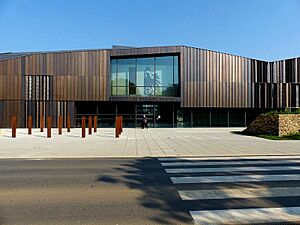
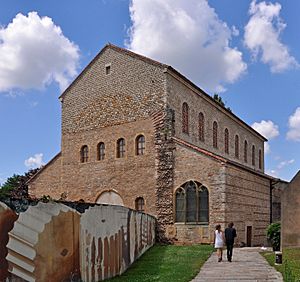
- The Centre Pompidou-Metz is a museum of modern and contemporary arts. It's the biggest place for temporary art exhibitions in France outside of Paris. The museum shows art from the huge collection of the Centre Georges Pompidou, which is Europe's largest collection of 20th-century art.
- Saint Stephen's Cathedral is a Gothic cathedral built in the 13th century. It's sometimes called "the Good Lord's Lantern" because it has the most stained-glass windows in the world (6,500 square meters or 70,000 sq ft!). These windows include works by famous artists from different periods.
- Another church in the city has a full set of stained-glass windows by the French artist Jean Cocteau.
Metz also has other museums and exhibition places:
- The FRAC Lorraine has a public collection of contemporary art from the Lorraine region. It's in a 12th-century mansion and hosts exhibitions by local and international artists.
- The Golden Courtyard (la Cour d'Or) is a museum about the history of Metz. It has sections on archeology, medieval times, architecture, and fine arts. You can see Gallo-Roman and medieval artifacts, and even the remains of ancient Roman baths.
- The Museum of the 1870 War and of the Annexion is in Gravelotte, a village near Metz. It's the only museum in Europe dedicated to the Franco-Prussian War. It shows military items and artworks from that time.
- The House for Europe is located at the home of Robert Schuman in Scy-Chazelles. It's now a museum and convention center that teaches visitors about Schuman's life and how Europe was built.
- Verlaine's House (la Maison de Verlaine) is a museum in the house where the poet Paul Verlaine was born. It's dedicated to his work and has both permanent and temporary exhibitions.
Fun and Shows
Metz has many places for performing arts. The Opera House of Metz, the oldest working opera house in France, hosts plays, dance shows, and operas. The Arsenal Concert Hall is famous for its amazing sound quality for classical music. The Trinitarians Club, in an old convent, is the main spot for jazz music. The Music Box (Boîte à Musique), also known as BAM, is where you can hear rock and electronic music. The Saint-Jacques Square is surrounded by lively bars and pubs with outdoor seating.
Since 2014, an old bus garage has been turned into a space for over thirty artists to create and rehearse their works. This art complex is called Metz Network of All Cultures (Toutes les Cultures en Réseau à Metz), or TCRM-Blida.
Metz in Art and Music
Metz was an important cultural center during the Carolingian Renaissance. For example, Gregorian chant was created in Metz in the 8th century by combining different music styles. It was called Messin Chant and is the oldest form of music still used in Western Europe. Metz was also a key place for creating illuminated manuscripts (decorated books) during the Carolingian period.
The Metz School was an art movement in Metz from 1834 to 1870, led by Charles-Laurent Maréchal. The artists were inspired by the medieval history of Metz and its beautiful surroundings. The Franco-Prussian War ended this art movement.
A festival called "Passages" happens in May, featuring many different shows.
The Graoully Dragon
The Graoully is a scary dragon from local legends. It was supposedly defeated by Saint Clement of Metz, the first Bishop of the city. The Graoully quickly became a symbol of Metz and appears on many city emblems since the 10th century. People in Metz often see this legend as a story about Christianity winning over paganism.
Local Food
Local specialties include quiche, a stew called potée, and Lorraine pâté. Many dishes, like jam, tarts, and fruit brandy, are made from the Mirabelle plum and Damsons. Metz also has its own pastries, such as Metz cheese pie and Metz Balls (boulet de Metz), which are chocolate biscuits covered in marzipan. Local drinks include Moselle wine and Amos beer.
The Covered Market of Metz is one of the oldest and grandest in France. It's full of traditional local food producers and shops. It was originally built as a bishop's palace, but during the French Revolution, citizens decided to turn it into a food market. The nearby Chamber's Square has many restaurants serving local food.
Fun Events and Celebrations
Many events are celebrated in Metz throughout the year. The city dedicates two weeks to the Mirabelle plum during the popular Mirabelle Festival in August. This festival includes markets selling fresh plums, tarts, and liquor, along with live music, fireworks, parties, art shows, a parade with flower floats, and the crowning of the Mirabelle Queen.
A literature festival is held in June. The Montgolfiades hot air balloon festival takes place in September. One of the most popular Christmas Markets in France is held in November and December. Finally, a Saint Nicholas parade honors the patron saint of the Lorraine region in December.
Sports in Metz
Metz is home to the Football Club of Metz (FC Metz), a professional football (soccer) team that plays in Ligue 1, the top French league. FC Metz has won the Ligue 2 three times and the Coupe de France twice. They also won the French League Cup twice. The Saint-Symphorien stadium has been their home since the club started.
Metz Handball is a very successful Handball club. Metz Handball has won the French Women's First League championship 23 times, and many other cups. The Metz Arena has been their home since 2002.
Since 2003, Metz has hosted the Moselle Open, a professional Tennis tournament that usually takes place in September.
| Club | Event | Sport | Leagues and Cups | Stadium |
|---|---|---|---|---|
| FC Metz | Association football | Ligue 1, French Cup, French League Cup | Saint-Symphorien stadium | |
| Metz Handball | Handball | French Women's First League, EHF Women's Champions League | Metz Arena | |
| Metz Hockey Club | Ice hockey | French Men's Second League | Saint-Symphorien Ice Ring | |
| Metz Ronde Pétanque | Pétanque | French Championship, European Cup | Saint-Symphorien Arena | |
| Metz TT | Table Tennis | French Women's Pro A; French Men's Pro B | Saint-Symphorien Arena | |
| Moselle Open | Tennis | ATP World Tour 250 tournament | Metz Arena | |
| Golden Mirabelle Open | Golf | Allianz Golf Tour | Technopole Golf Course | |
| Mirabelle Metz Marathon | Athletics | Metz Urban Agglomeration |
Learning in Metz
High Schools
Metz has many high schools, including the Fabert High School. Some of these schools offer higher education courses for students preparing for university or technical careers.
University of Lorraine
Metz is also home to the University of Lorraine (UL). This university has two main centers: one in Metz (focused on materials science, technology, and management) and one in Nancy (focused on biological sciences, health care, and law). The University of Lorraine is a top university, ranking among the best in France and the world. It has over 55,000 students and many research centers.
Graduate Schools
In the late 1990s, Metz grew and created the Metz Science Park. Several graduate schools opened campuses there. These include Supélec (1985) and Georgia Tech Lorraine (1990). In 1996, the engineering school Arts et Métiers ParisTech (ENSAM) built a research and learning center. These schools often work together with the University of Lorraine.
Getting Around Metz
Local Travel
Public transport in Metz includes a bus rapid transit system called Mettis. Mettis uses special hybrid buses that stop at elevated stations, making them easy to access for everyone. The Mettis system has two dedicated lines that connect major parts of the city, like the city center, university, and hospitals. A main transport hub is located near the railway station.
Train Travel
The Metz Railway Station is connected to France's high-speed train (TGV) network. You can take a direct train to Paris (in 82 minutes) and Luxembourg. There's also the Lorraine TGV railway station, about 25 kilometers (15.5 miles) south of Metz, for high-speed trains going to other French cities like Nantes and Lille without stopping in Paris. Metz is also a main station for regional trains.
Roads
Metz is located where two major motorways meet: the Eastern Motorway (part of a route connecting Paris to Prague) and the A31 Motorway, which goes north to Luxembourg and south towards Nancy and Lyon.
Airports
The Luxembourg International Airport is the closest international airport, and you can reach it by train from Metz. The Lorraine TGV Station is also 75 minutes by train from France's main international airport, Charles de Gaulle Airport. Finally, Metz–Nancy–Lorraine Airport is about 16.5 kilometers (10 miles) southeast of Metz.
Waterways
Metz is located where the Moselle and Seille rivers meet. Both rivers are navigable, meaning boats can travel on them. The city's marina connects Metz to other cities along the Moselle valley, like Trier and Koblenz.
Top Sights in Metz
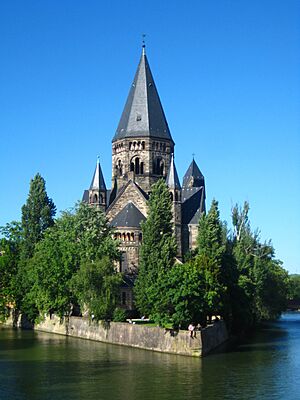
Religious Buildings
- The Gothic Saint Stephen's cathedral was built in the 13th century. It's called "the Good Lord's Lantern" because it has the most stained glass windows in the world and one of the highest naves (main parts) of any church.
- The Saint-Pierre-aux-Nonnains basilica is one of the oldest churches in the world and where Gregorian Chant began.
- Saint Maximin's church features stained glass windows by French artist Jean Cocteau.
- The 13th-century Romanesque Knights Templar's chapel was once part of the oldest Templar institution in the Holy Roman Empire.
Historic City Buildings
- The opera house of Metz Metropole was built in the 18th century. It's the oldest working opera house in France and one of the oldest in Europe.
- You can see the birthplaces of famous people like poet Paul Verlaine and inventor Jean-François Pilâtre de Rozier.
- The house of François Rabelais, a writer who came to Metz to avoid trouble for his ideas.
- Many medieval buildings, including old granaries and several grand private homes.
Government and Public Buildings
- The main town square and its surrounding Neoclassical buildings were designed by French architect Jacques-François Blondel.
- The Neoclassical courthouse (which used to be the Governor's Palace) was built by French artist Charles-Louis Clérisseau. This is where Lafayette decided to support the American Revolutionary War in 1775.
- The Romanesque Revival Station-Palace (train station) and Central Post Office were built by German architect Jürgen Kröger.
Military Sights
- The German's Gate from the 13th century is the last medieval bridge castle in France. It played a key role in defending Metz during a siege in 1552–53.
- You can see the ruins of the city's defensive walls from ancient times up to the 18th century, and the large 19th and 20th-century fortifications of Metz.
- The Fort of Queuleu was used by the Germans during the Second World War to hold and question members of the French Resistance.
- The war memorial is an art deco sculpture by French artist Paul Niclausse showing a mother holding her dead son.
Metz and the World
Metz is part of the QuattroPole union of cities, which also includes Luxembourg, Saarbrücken, and Trier (from Luxembourg, France, and Germany). Metz is a central city in the larger Greater Region and the economic SaarLorLux Euroregion. Metz is also twinned with several cities around the world:
 Trier, Germany (since 1957)
Trier, Germany (since 1957) Gloucester, England, United Kingdom (since 1967)
Gloucester, England, United Kingdom (since 1967) Karmiel, Israel (since 1984)
Karmiel, Israel (since 1984) Saint-Denis, Réunion, France (since 1986)
Saint-Denis, Réunion, France (since 1986) Yichang, China (since 1991)
Yichang, China (since 1991) Hradec Králové, Czech Republic (since 2001)
Hradec Králové, Czech Republic (since 2001) Kansas City, United States of America (since 2003)
Kansas City, United States of America (since 2003) Djambala, Republic of Congo (since 2012)
Djambala, Republic of Congo (since 2012) Nanjing, China (since 2019)
Nanjing, China (since 2019) Chernivtsi, Ukraine (since 2022)
Chernivtsi, Ukraine (since 2022)
Images for kids
See also
 In Spanish: Metz para niños
In Spanish: Metz para niños





